stop start TOYOTA BZ4X 2022 (in English) Workshop Manual
[x] Cancel search | Manufacturer: TOYOTA, Model Year: 2022, Model line: BZ4X, Model: TOYOTA BZ4X 2022Pages: 674, PDF Size: 120.02 MB
Page 253 of 674
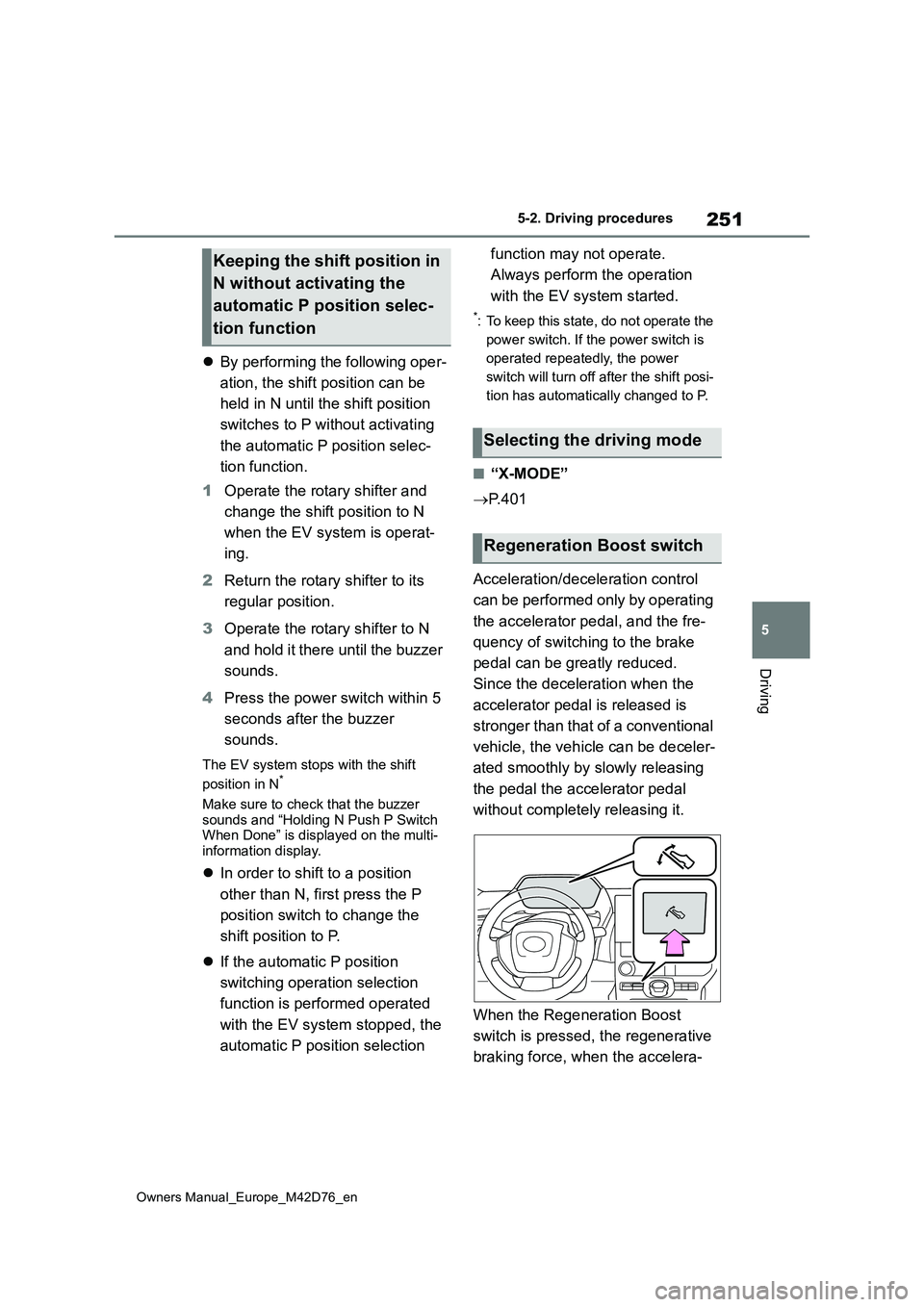
251
5
Owners Manual_Europe_M42D76_en
5-2. Driving procedures
Driving
By performing the following oper-
ation, the shift position can be
held in N until the shift position
switches to P without activating
the automatic P position selec-
tion function.
1 Operate the rotary shifter and
change the shift position to N
when the EV system is operat-
ing.
2 Return the rotary shifter to its
regular position.
3 Operate the rotary shifter to N
and hold it there until the buzzer
sounds.
4 Press the power switch within 5
seconds after the buzzer
sounds.
The EV system stops with the shift
position in N*
Make sure to check that the buzzer sounds and “Holding N Push P Switch When Done” is displayed on the multi-
information display.
In order to shift to a position
other than N, first press the P
position switch to change the
shift position to P.
If the automatic P position
switching operation selection
function is performed operated
with the EV system stopped, the
automatic P position selection
function may not operate.
Always perform the operation
with the EV system started.
*: To keep this state, do not operate the
power switch. If the power switch is
operated repeatedly, the power
switch will turn off after the shift posi-
tion has automatically changed to P.
■“X-MODE”
P. 4 0 1
Acceleration/deceleration control
can be performed only by operating
the accelerator pedal, and the fre-
quency of switching to the brake
pedal can be greatly reduced.
Since the deceleration when the
accelerator pedal is released is
stronger than that of a conventional
vehicle, the vehicle can be deceler-
ated smoothly by slowly releasing
the pedal the accelerator pedal
without completely releasing it.
When the Regeneration Boost
switch is pressed, the regenerative
braking force, when the accelera-
Keeping the shift position in
N without activating the
automatic P position selec-
tion function
Selecting the driving mode
Regeneration Boost switch
Page 254 of 674
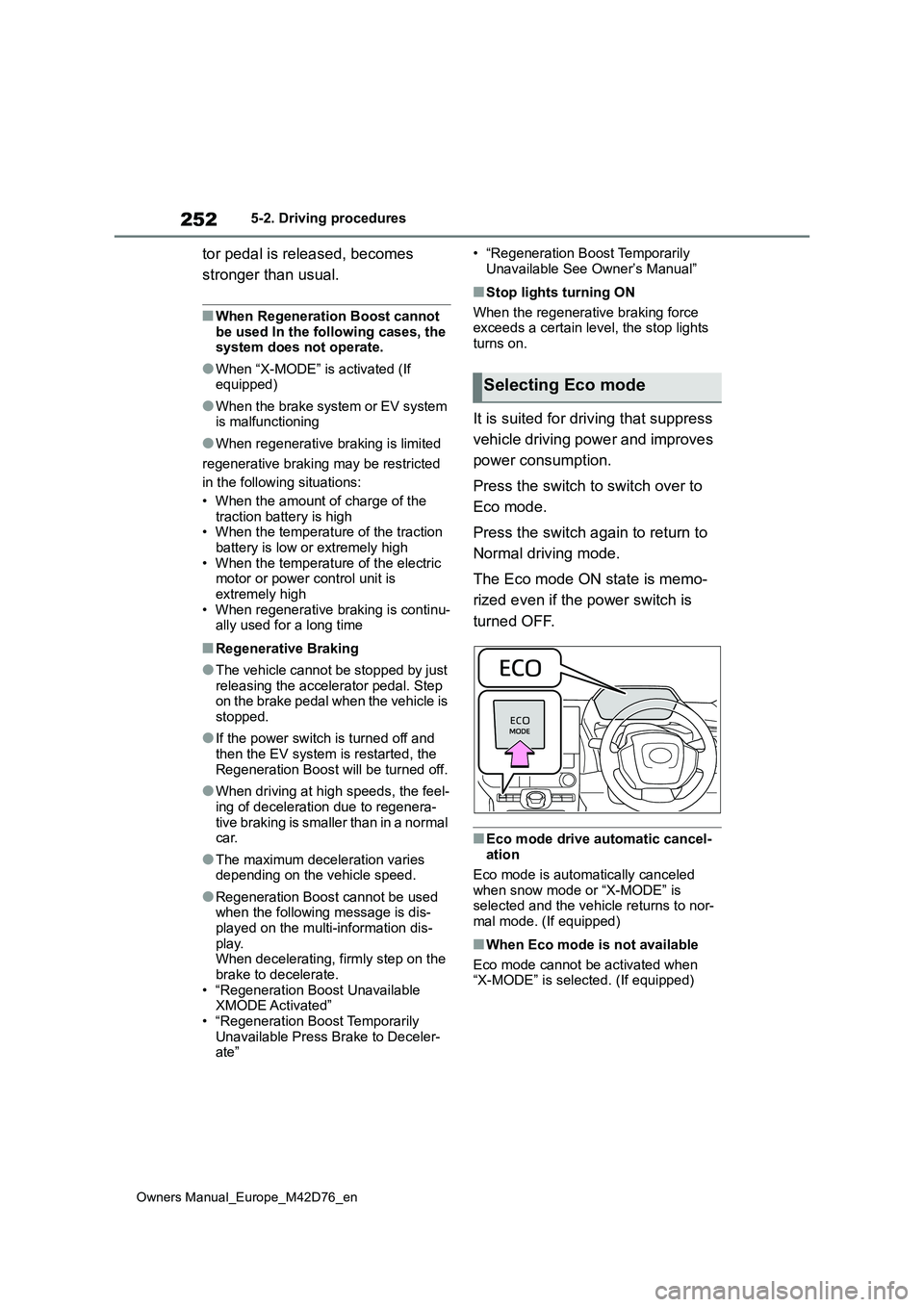
252
Owners Manual_Europe_M42D76_en
5-2. Driving procedures
tor pedal is released, becomes
stronger than usual.
■When Regeneration Boost cannot be used In the following cases, the system does not operate.
●When “X-MODE” is activated (If equipped)
●When the brake system or EV system is malfunctioning
●When regenerative braking is limited
regenerative braking may be restricted
in the following situations:
• When the amount of charge of the
traction battery is high • When the temperature of the traction battery is low or extremely high
• When the temperature of the electric motor or power control unit is extremely high
• When regenerative braking is continu- ally used for a long time
■Regenerative Braking
●The vehicle cannot be stopped by just releasing the accelerator pedal. Step on the brake pedal when the vehicle is
stopped.
●If the power switch is turned off and
then the EV system is restarted, the Regeneration Boost will be turned off.
●When driving at high speeds, the feel-ing of deceleration due to regenera-
tive braking is smaller than in a normal car.
●The maximum deceleration varies depending on the vehicle speed.
●Regeneration Boost cannot be used when the following message is dis-played on the multi-information dis-
play. When decelerating, firmly step on the brake to decelerate.
• “Regeneration Boost Unavailable XMODE Activated”• “Regeneration Boost Temporarily
Unavailable Press Brake to Deceler- ate”
• “Regeneration Boost Temporarily
Unavailable See Owner’s Manual”
■Stop lights turning ON
When the regenerative braking force exceeds a certain level, the stop lights
turns on.
It is suited for driving that suppress
vehicle driving power and improves
power consumption.
Press the switch to switch over to
Eco mode.
Press the switch again to return to
Normal driving mode.
The Eco mode ON state is memo-
rized even if the power switch is
turned OFF.
■Eco mode drive automatic cancel- ation
Eco mode is automatically canceled
when snow mode or “X-MODE” is selected and the vehicle returns to nor-
mal mode. (If equipped)
■When Eco mode is not available
Eco mode cannot be activated when “X-MODE” is selected. (If equipped)
Selecting Eco mode
Page 259 of 674
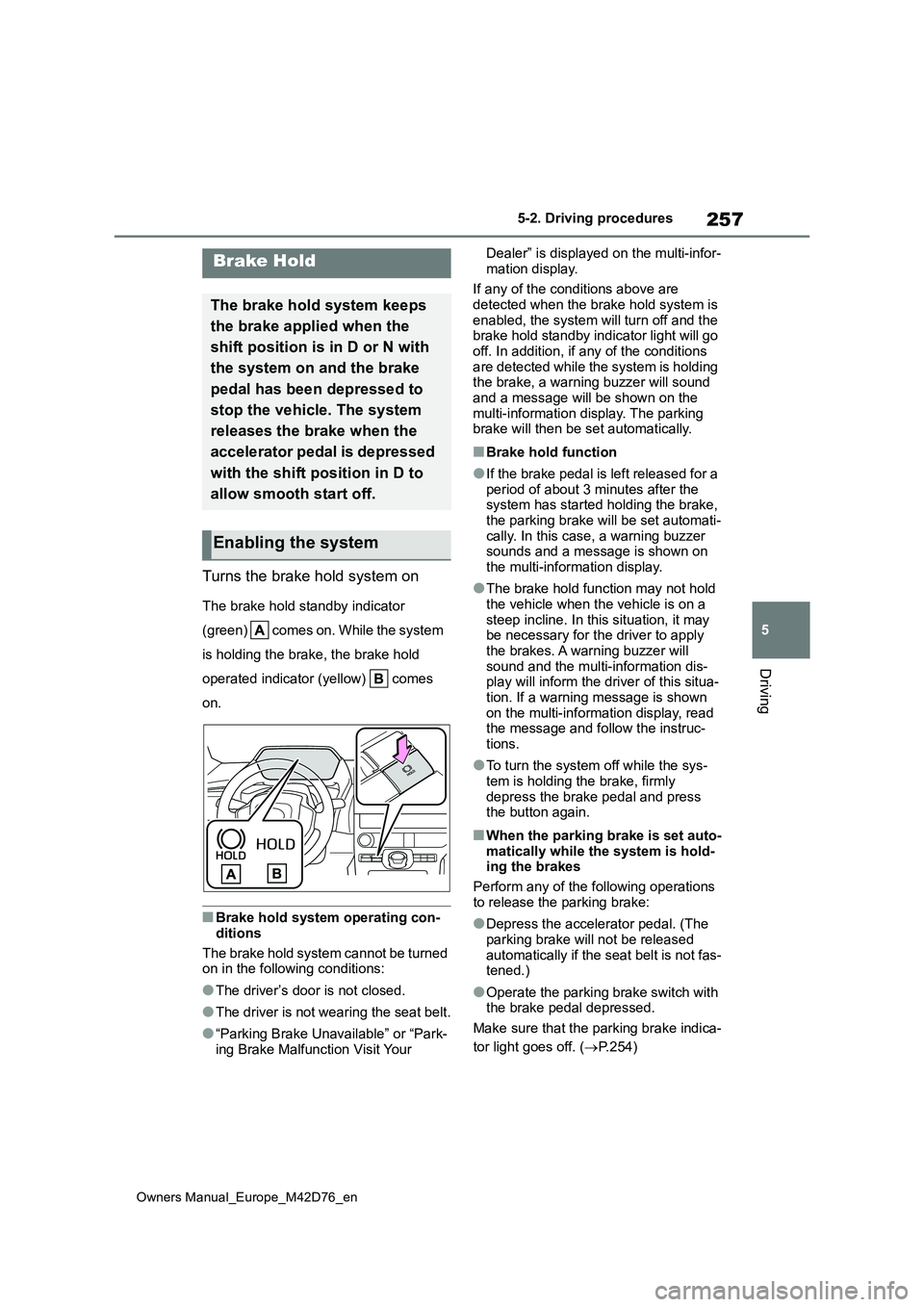
257
5
Owners Manual_Europe_M42D76_en
5-2. Driving procedures
Driving
Turns the brake hold system on
The brake hold standby indicator
(green) comes on. While the system
is holding the brake, the brake hold
operated indicator (yellow) comes
on.
■Brake hold system operating con-
ditions
The brake hold system cannot be turned on in the following conditions:
●The driver’s door is not closed.
●The driver is not wearing the seat belt.
●“Parking Brake Unavailable” or “Park-
ing Brake Malfunction Visit Your
Dealer” is displayed on the multi-infor-
mation display.
If any of the conditions above are detected when the brake hold system is
enabled, the system will turn off and the brake hold standby indicator light will go off. In addition, if any of the conditions
are detected while the system is holding the brake, a warning buzzer will sound and a message will be shown on the
multi-information display. The parking brake will then be set automatically.
■Brake hold function
●If the brake pedal is left released for a period of about 3 minutes after the system has started holding the brake,
the parking brake will be set automati- cally. In this case, a warning buzzer sounds and a message is shown on
the multi-information display.
●The brake hold function may not hold
the vehicle when the vehicle is on a steep incline. In this situation, it may be necessary for the driver to apply
the brakes. A warning buzzer will sound and the multi-information dis-play will inform the driver of this situa-
tion. If a warning message is shown on the multi-information display, read the message and follow the instruc-
tions.
●To turn the system off while the sys-
tem is holding the brake, firmly depress the brake pedal and press the button again.
■When the parking brake is set auto-
matically while the system is hold- ing the brakes
Perform any of the following operations
to release the parking brake:
●Depress the accelerator pedal. (The
parking brake will not be released automatically if the seat belt is not fas-tened.)
●Operate the parking brake switch with the brake pedal depressed.
Make sure that the parking brake indica-
tor light goes off. ( P.254)
Brake Hold
The brake hold system keeps
the brake applied when the
shift position is in D or N with
the system on and the brake
pedal has been depressed to
stop the vehicle. The system
releases the brake when the
accelerator pedal is depressed
with the shift position in D to
allow smooth start off.
Enabling the system
Page 311 of 674
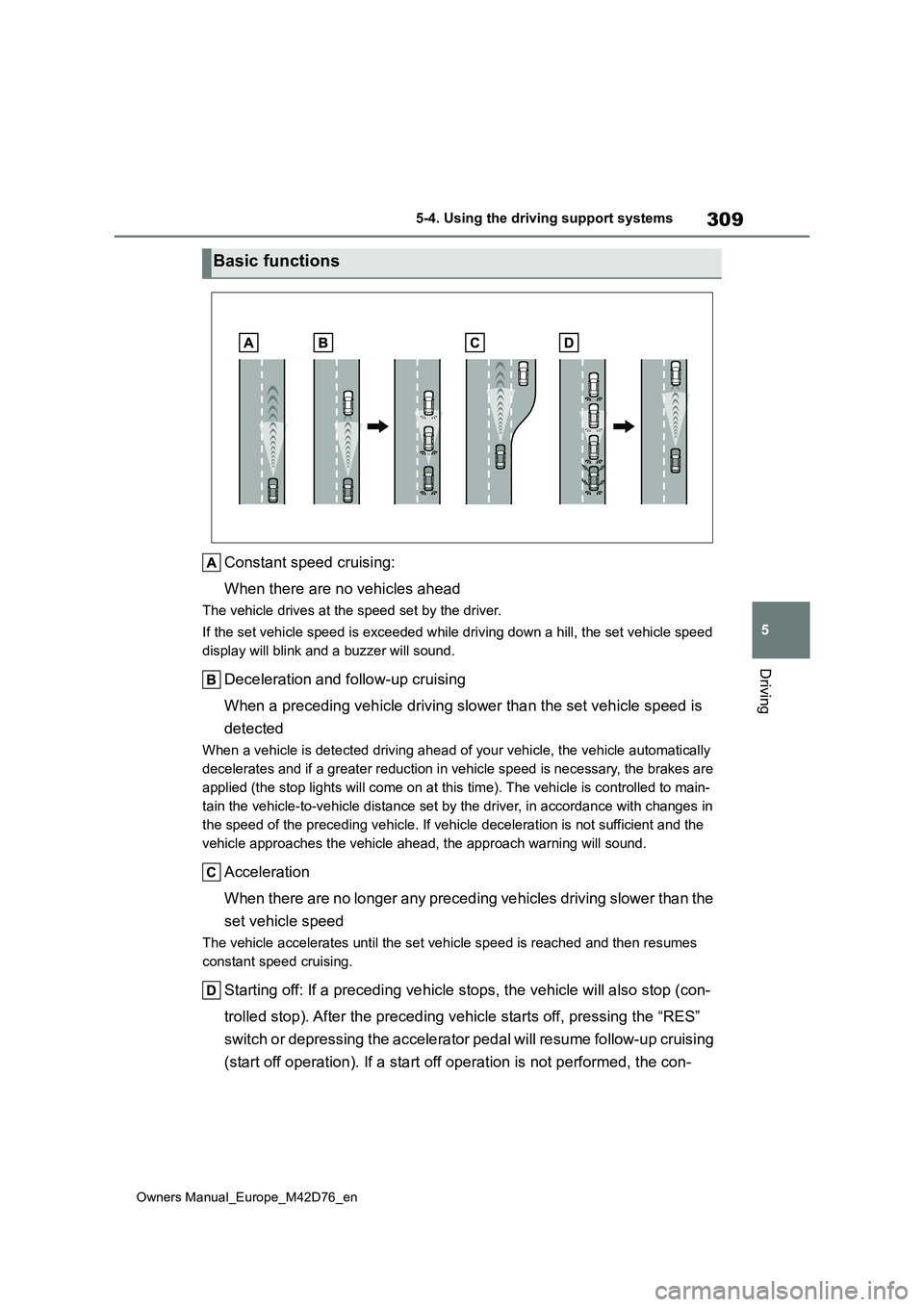
309
5
Owners Manual_Europe_M42D76_en
5-4. Using the driving support systems
Driving
Constant speed cruising:
When there are no vehicles ahead
The vehicle drives at the speed set by the driver.
If the set vehicle speed is exceeded while driving down a hill, the set vehicle speed
display will blink and a buzzer will sound.
Deceleration and follow-up cruising
When a preceding vehicle driving slower than the set vehicle sp eed is
detected
When a vehicle is detected driving ahead of your vehicle, the v ehicle automatically
decelerates and if a greater reduction in vehicle speed is nece ssary, the brakes are
applied (the stop lights will come on at this time). The vehicl e is controlled to main-
tain the vehicle-to-vehicle distance set by the driver, in acco rdance with changes in
the speed of the preceding vehicle. If vehicle deceleration is not sufficient and the
vehicle approaches the vehicle ahead, the approach warning will sound.
Acceleration
When there are no longer any preceding vehicles driving slower than the
set vehicle speed
The vehicle accelerates until the set vehicle speed is reached and then resumes
constant speed cruising.
Starting off: If a preceding vehicle stops, the vehicle will al so stop (con-
trolled stop). After the preceding vehicle starts off, pressing the “RES”
switch or depressing the accelerator pedal will resume follow-u p cruising
(start off operation). If a start off operation is not performe d, the con-
Basic functions
Page 314 of 674
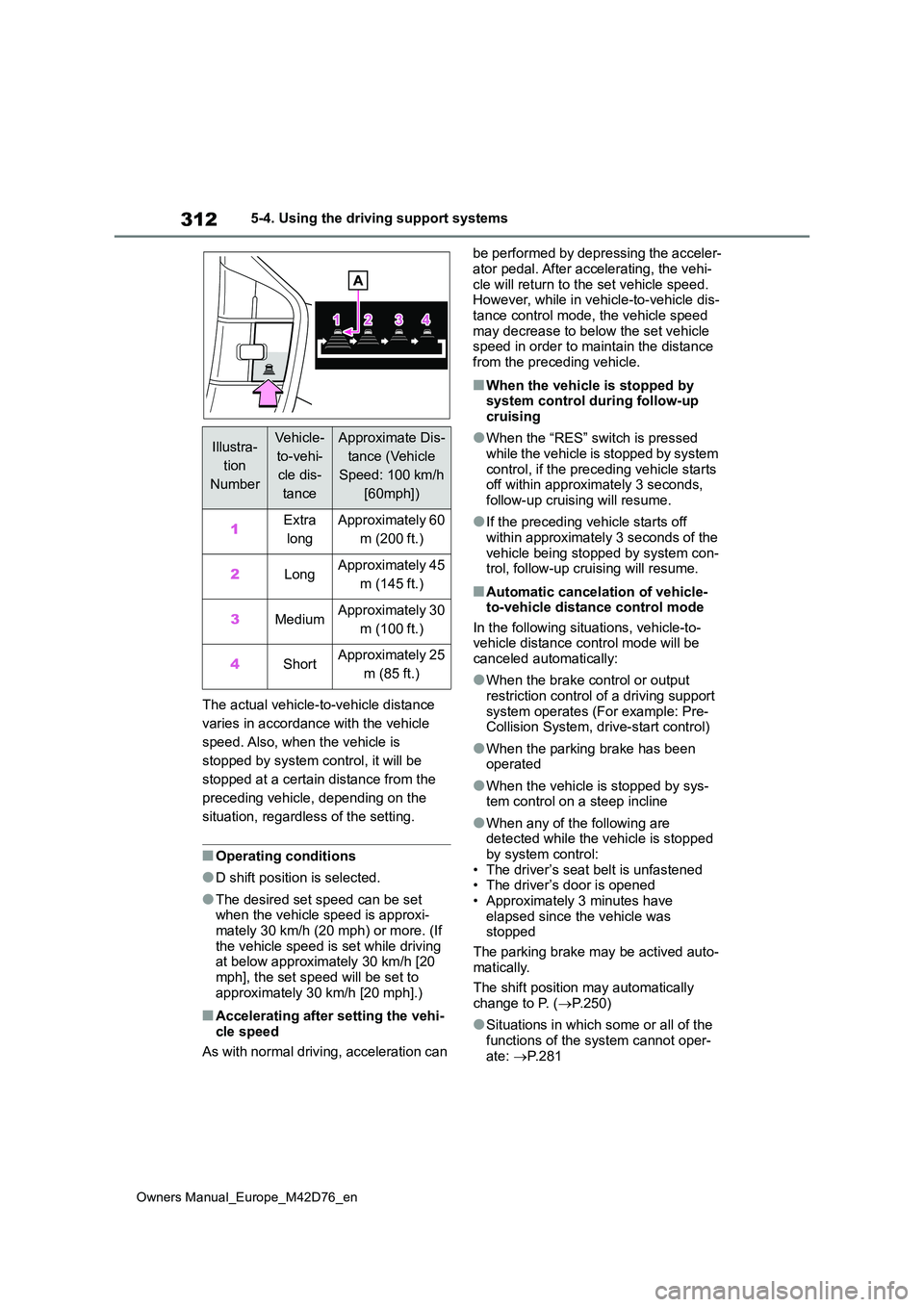
312
Owners Manual_Europe_M42D76_en
5-4. Using the driving support systems
The actual vehicle-to-vehicle distance
varies in accordance with the vehicle
speed. Also, when the vehicle is
stopped by system control, it will be
stopped at a certain distance from the
preceding vehicle, depending on the
situation, regardless of the setting.
■Operating conditions
●D shift position is selected.
●The desired set speed can be set when the vehicle speed is approxi-
mately 30 km/h (20 mph) or more. (If the vehicle speed is set while driving at below approximately 30 km/h [20
mph], the set speed will be set to approximately 30 km/h [20 mph].)
■Accelerating after setting the vehi-cle speed
As with normal driving, acceleration can
be performed by depressing the acceler-
ator pedal. After accelerating, the vehi- cle will return to the set vehicle speed. However, while in vehicle-to-vehicle dis-
tance control mode, the vehicle speed may decrease to below the set vehicle speed in order to maintain the distance
from the preceding vehicle.
■When the vehicle is stopped by system control during follow-up cruising
●When the “RES” switch is pressed while the vehicle is stopped by system
control, if the preceding vehicle starts off within approximately 3 seconds, follow-up cruising will resume.
●If the preceding vehicle starts off within approximately 3 seconds of the
vehicle being stopped by system con- trol, follow-up cruising will resume.
■Automatic cancelation of vehicle-to-vehicle distance control mode
In the following situations, vehicle-to- vehicle distance control mode will be canceled automatically:
●When the brake control or output restriction control of a driving support
system operates (For example: Pre- Collision System, drive-start control)
●When the parking brake has been operated
●When the vehicle is stopped by sys-tem control on a steep incline
●When any of the following are detected while the vehicle is stopped by system control:
• The driver’s seat belt is unfastened • The driver’s door is opened• Approximately 3 minutes have
elapsed since the vehicle was stopped
The parking brake may be actived auto-
matically.
The shift position may automatically change to P. ( P.250)
●Situations in which some or all of the functions of the system cannot oper-
ate: P. 2 8 1
Illustra-
tion
Number
Ve hi cl e -
to-vehi-
cle dis-
tance
Approximate Dis-
tance (Vehicle
Speed: 100 km/h
[60mph])
1Extra
long
Approximately 60
m (200 ft.)
2LongApproximately 45
m (145 ft.)
3MediumApproximately 30
m (100 ft.)
4ShortApproximately 25
m (85 ft.)
Page 325 of 674
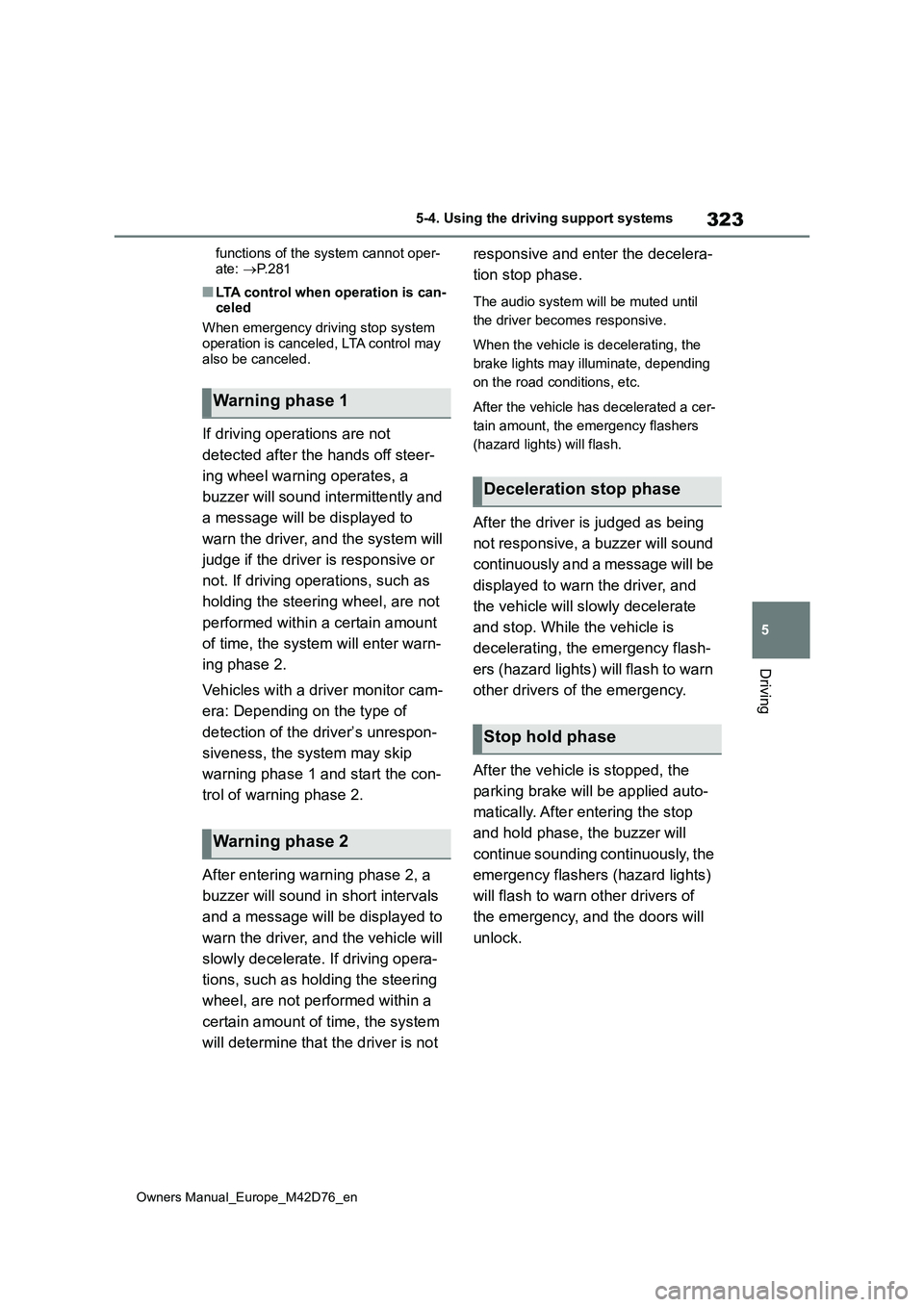
323
5
Owners Manual_Europe_M42D76_en
5-4. Using the driving support systems
Driving
functions of the system cannot oper-
ate: P. 2 8 1
■LTA control when operation is can- celed
When emergency driving stop system
operation is canceled, LTA control may also be canceled.
If driving operations are not
detected after the hands off steer-
ing wheel warning operates, a
buzzer will sound intermittently and
a message will be displayed to
warn the driver, and the system will
judge if the driver is responsive or
not. If driving operations, such as
holding the steering wheel, are not
performed within a certain amount
of time, the system will enter warn-
ing phase 2.
Vehicles with a driver monitor cam-
era: Depending on the type of
detection of the driver’s unrespon-
siveness, the system may skip
warning phase 1 and start the con-
trol of warning phase 2.
After entering warning phase 2, a
buzzer will sound in short intervals
and a message will be displayed to
warn the driver, and the vehicle will
slowly decelerate. If driving opera-
tions, such as holding the steering
wheel, are not performed within a
certain amount of time, the system
will determine that the driver is not
responsive and enter the decelera-
tion stop phase.
The audio system will be muted until
the driver becomes responsive.
When the vehicle is decelerating, the
brake lights may illuminate, depending
on the road conditions, etc.
After the vehicle has decelerated a cer-
tain amount, the emergency flashers
(hazard lights) will flash.
After the driver is judged as being
not responsive, a buzzer will sound
continuously and a message will be
displayed to warn the driver, and
the vehicle will slowly decelerate
and stop. While the vehicle is
decelerating, the emergency flash-
ers (hazard lights) will flash to warn
other drivers of the emergency.
After the vehicle is stopped, the
parking brake will be applied auto-
matically. After entering the stop
and hold phase, the buzzer will
continue sounding continuously, the
emergency flashers (hazard lights)
will flash to warn other drivers of
the emergency, and the doors will
unlock.
Warning phase 1
Warning phase 2
Deceleration stop phase
Stop hold phase
Page 329 of 674
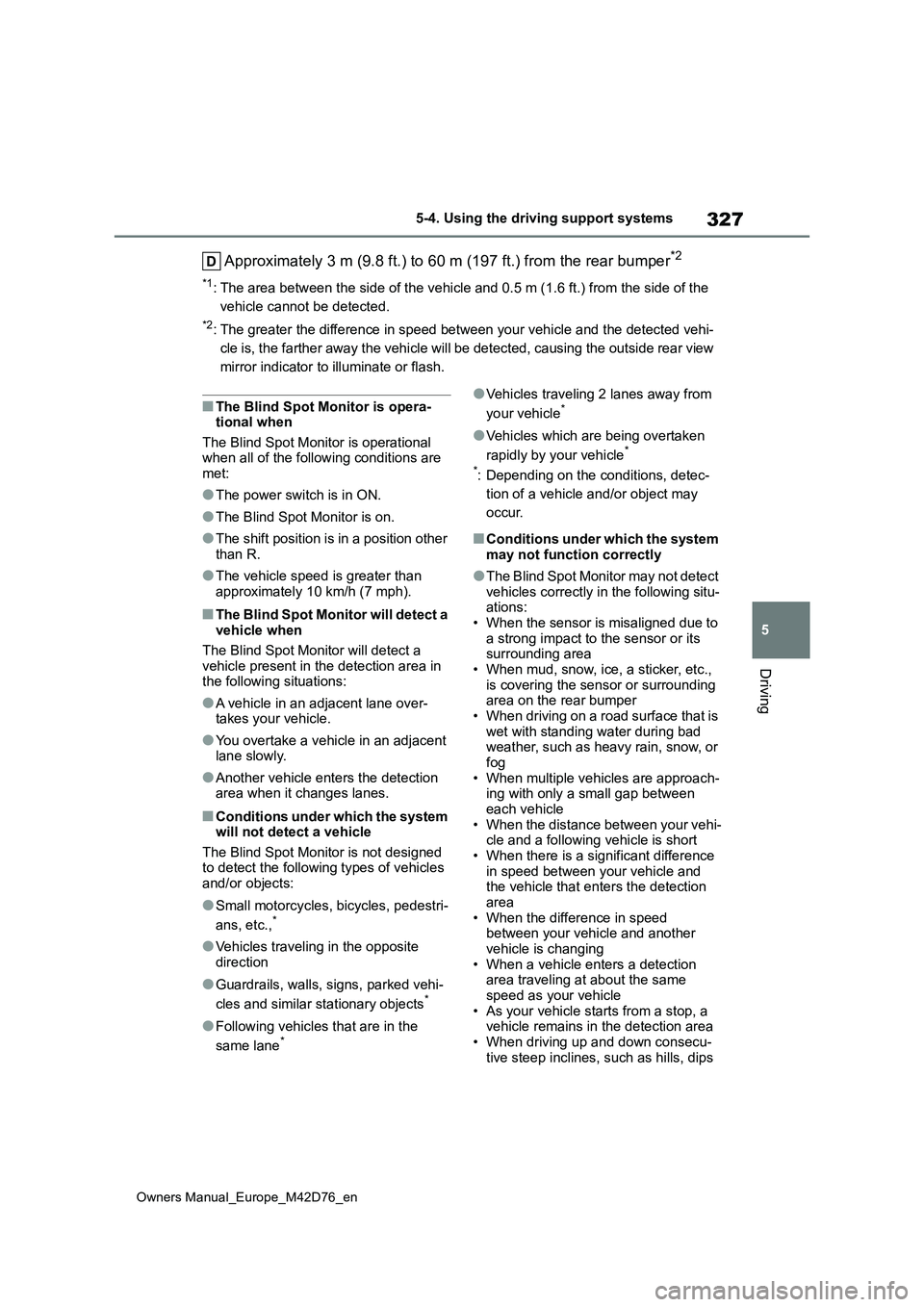
327
5
Owners Manual_Europe_M42D76_en
5-4. Using the driving support systems
Driving
Approximately 3 m (9.8 ft.) to 60 m (197 ft.) from the rear bumper*2
*1: The area between the side of the vehicle and 0.5 m (1.6 ft.) from the side of the
vehicle cannot be detected.
*2: The greater the difference in speed between your vehicle and t he detected vehi-
cle is, the farther away the vehicle will be detected, causing the outside rear view
mirror indicator to illuminate or flash.
■The Blind Spot Monitor is opera- tional when
The Blind Spot Monitor is operational when all of the following conditions are met:
●The power switch is in ON.
●The Blind Spot Monitor is on.
●The shift position is in a position other
than R.
●The vehicle speed is greater than
approximately 10 km/h (7 mph).
■The Blind Spot Monitor will detect a vehicle when
The Blind Spot Monitor will detect a
vehicle present in the detection area in the following situations:
●A vehicle in an adjacent lane over-takes your vehicle.
●You overtake a vehicle in an adjacent lane slowly.
●Another vehicle enters the detection area when it changes lanes.
■Conditions under which the system will not detect a vehicle
The Blind Spot Monitor is not designed to detect the following types of vehicles and/or objects:
●Small motorcycles, bicycles, pedestri-
ans, etc.,*
●Vehicles traveling in the opposite direction
●Guardrails, walls, signs, parked vehi-
cles and similar stationary objects*
●Following vehicles that are in the
same lane*
●Vehicles traveling 2 lanes away from
your vehicle*
●Vehicles which are being overtaken
rapidly by your vehicle*
*: Depending on the conditions, detec-
tion of a vehicle and/or object may
occur.
■Conditions under which the system may not function correctly
●The Blind Spot Monitor may not detect vehicles correctly in the following situ-ations:
• When the sensor is misaligned due to a strong impact to the sensor or its surrounding area
• When mud, snow, ice, a sticker, etc., is covering the sensor or surrounding area on the rear bumper
• When driving on a road surface that is wet with standing water during bad weather, such as heavy rain, snow, or
fog • When multiple vehicles are approach-ing with only a small gap between
each vehicle • When the distance between your vehi-cle and a following vehicle is short
• When there is a significant difference in speed between your vehicle and the vehicle that enters the detection
area • When the difference in speed between your vehicle and another
vehicle is changing • When a vehicle enters a detection area traveling at about the same
speed as your vehicle • As your vehicle starts from a stop, a vehicle remains in the detection area
• When driving up and down consecu- tive steep inclines, such as hills, dips
Page 334 of 674
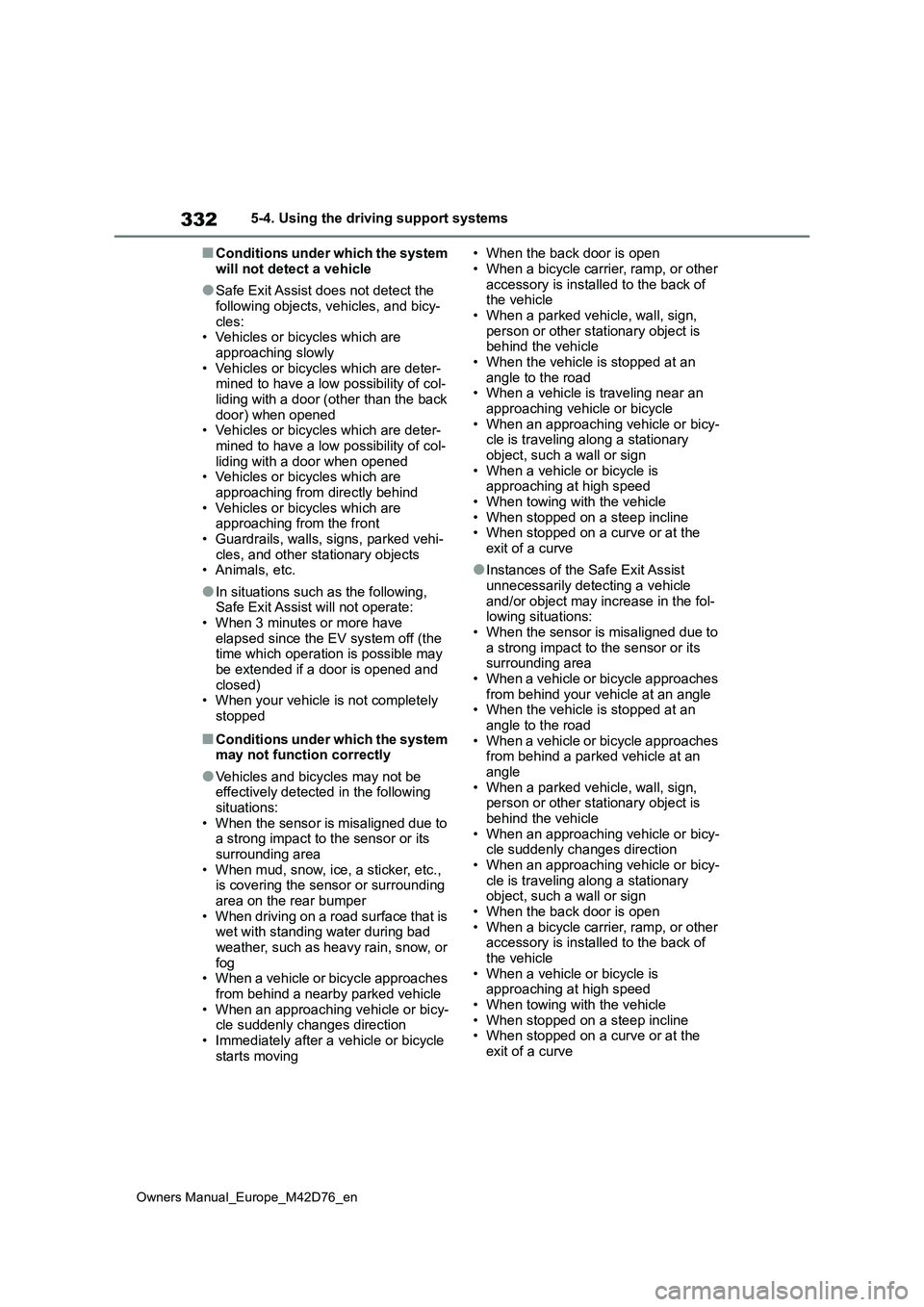
332
Owners Manual_Europe_M42D76_en
5-4. Using the driving support systems
■Conditions under which the system
will not detect a vehicle
●Safe Exit Assist does not detect the
following objects, vehicles, and bicy- cles:• Vehicles or bicycles which are
approaching slowly • Vehicles or bicycles which are deter-mined to have a low possibility of col-
liding with a door (other than the back door) when opened• Vehicles or bicycles which are deter-
mined to have a low possibility of col- liding with a door when opened• Vehicles or bicycles which are
approaching from directly behind • Vehicles or bicycles which are approaching from the front
• Guardrails, walls, signs, parked vehi- cles, and other stationary objects• Animals, etc.
●In situations such as the following, Safe Exit Assist will not operate:
• When 3 minutes or more have elapsed since the EV system off (the time which operation is possible may
be extended if a door is opened and closed)• When your vehicle is not completely
stopped
■Conditions under which the system may not function correctly
●Vehicles and bicycles may not be effectively detected in the following situations:
• When the sensor is misaligned due to a strong impact to the sensor or its surrounding area
• When mud, snow, ice, a sticker, etc., is covering the sensor or surrounding area on the rear bumper
• When driving on a road surface that is wet with standing water during bad weather, such as heavy rain, snow, or
fog • When a vehicle or bicycle approaches from behind a nearby parked vehicle
• When an approaching vehicle or bicy- cle suddenly changes direction• Immediately after a vehicle or bicycle
starts moving
• When the back door is open
• When a bicycle carrier, ramp, or other accessory is installed to the back of the vehicle
• When a parked vehicle, wall, sign, person or other stationary object is behind the vehicle
• When the vehicle is stopped at an angle to the road• When a vehicle is traveling near an
approaching vehicle or bicycle • When an approaching vehicle or bicy-cle is traveling along a stationary
object, such a wall or sign • When a vehicle or bicycle is approaching at high speed
• When towing with the vehicle • When stopped on a steep incline• When stopped on a curve or at the
exit of a curve
●Instances of the Safe Exit Assist
unnecessarily detecting a vehicle and/or object may increase in the fol-lowing situations:
• When the sensor is misaligned due to a strong impact to the sensor or its surrounding area
• When a vehicle or bicycle approaches from behind your vehicle at an angle• When the vehicle is stopped at an
angle to the road • When a vehicle or bicycle approaches from behind a parked vehicle at an
angle • When a parked vehicle, wall, sign, person or other stationary object is
behind the vehicle • When an approaching vehicle or bicy-cle suddenly changes direction
• When an approaching vehicle or bicy- cle is traveling along a stationary object, such a wall or sign
• When the back door is open • When a bicycle carrier, ramp, or other accessory is installed to the back of
the vehicle • When a vehicle or bicycle is approaching at high speed
• When towing with the vehicle • When stopped on a steep incline• When stopped on a curve or at the
exit of a curve
Page 343 of 674
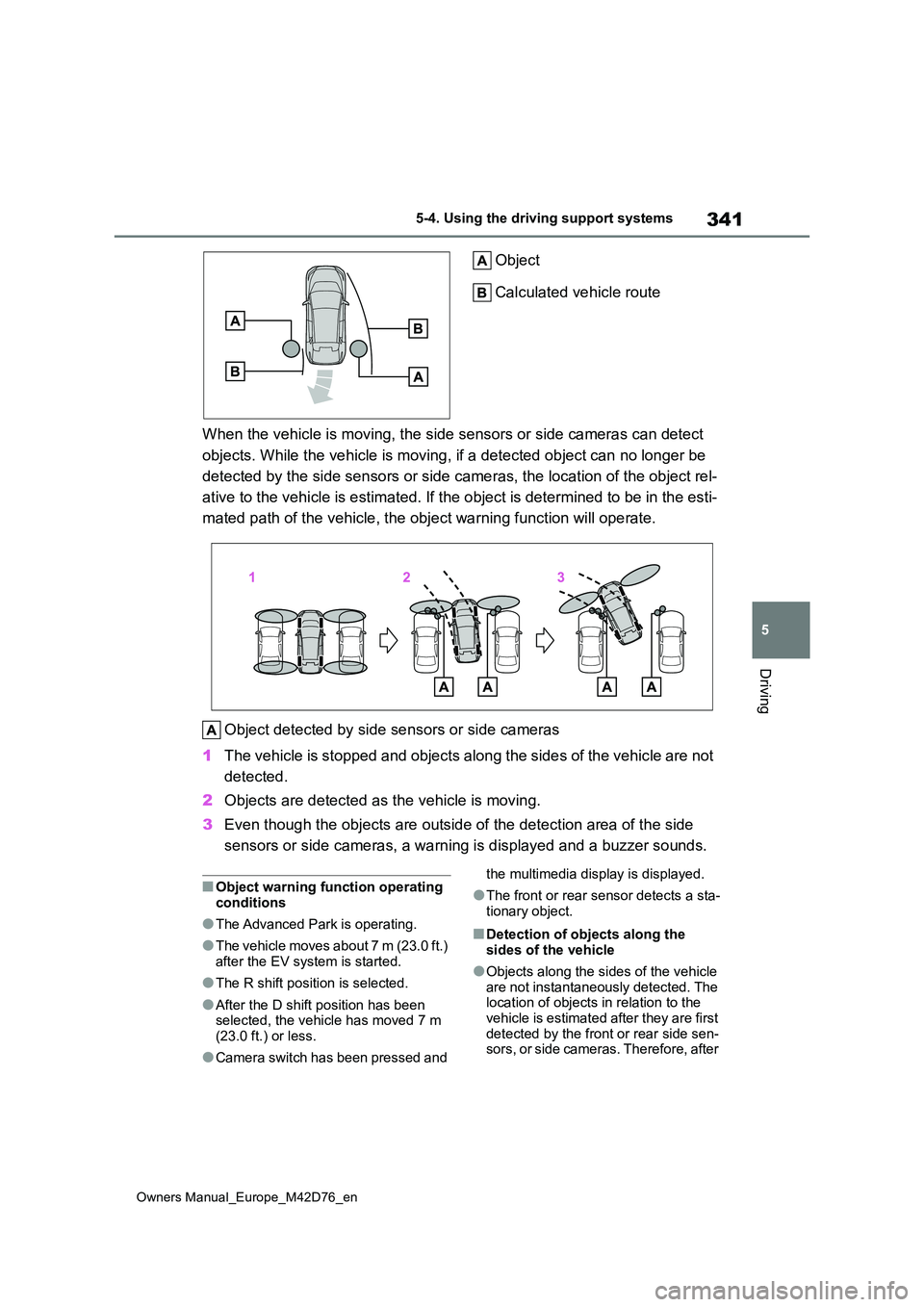
341
5
Owners Manual_Europe_M42D76_en
5-4. Using the driving support systems
Driving
Object
Calculated vehicle route
When the vehicle is moving, the side sensors or side cameras ca n detect
objects. While the vehicle is moving, if a detected object can no longer be
detected by the side sensors or side cameras, the location of t he object rel-
ative to the vehicle is estimated. If the object is determined to be in the esti-
mated path of the vehicle, the object warning function will ope rate.
Object detected by side sensors or side cameras
1 The vehicle is stopped and objects along the sides of the vehicle are not
detected.
2 Objects are detected as the vehicle is moving.
3 Even though the objects are outside of the detection area of the side
sensors or side cameras, a warning is displayed and a buzzer so unds.
■Object warning function operating conditions
●The Advanced Park is operating.
●The vehicle moves about 7 m (23.0 ft.)
after the EV system is started.
●The R shift position is selected.
●After the D shift position has been selected, the vehicle has moved 7 m
(23.0 ft.) or less.
●Camera switch has been pressed and
the multimedia display is displayed.
●The front or rear sensor detects a sta-
tionary object.
■Detection of objects along the sides of the vehicle
●Objects along the sides of the vehicle are not instantaneously detected. The location of objects in relation to the
vehicle is estimated after they are first detected by the front or rear side sen-sors, or side cameras. Therefore, after
Page 360 of 674

358
Owners Manual_Europe_M42D76_en
5-4. Using the driving support systems
■When the vehicle moves in the
unintended direction due to
the wrong shift position being
selected
P. 3 3 3
■The system will operate when
The function will operate when the driv-
ing assist information indicator is not illu- minated ( P.169, 519) and all of the following conditions are met:
●EV system output restriction control• The Parking Support Brake is
enabled.
• The vehicle speed is approximately 15
km/h (9 mph) or less. • There is a static object in the traveling direction of the vehicle and approxi-
mately 2 to 4 m (6 to 13 ft.) away. • The Parking Support Brake deter-mines that a stronger-than-normal
brake operation is necessary to avoid a collision.
●Brake control• EV system output restriction control is operating.
• The Parking Support Brake deter- mines that an immediate brake opera-tion is necessary to avoid a collision.
■The system will stop operating
when
The function will stop operating if any of the following conditions are met:
●EV system output restriction control• The Parking Support Brake is dis-
abled. • The system determines that the colli-sion has become avoidable with nor-
mal brake operation. • The static object is no longer approxi-mately 2 to 4 m (6 to 13 ft.) away from
the vehicle or in the traveling direction of the vehicle.
●Brake control• The Parking Support Brake is dis-abled.
• Approximately 2 seconds have elapsed since the vehicle was stopped by brake control.
• The brake pedal is depressed after the vehicle is stopped by brake con-trol.
• The static object is no longer approxi- mately 2 to 4 m (6 to 13 ft.) away from the vehicle or in the traveling direction
of the vehicle.
■Detection range
The detection range of the system dif- fers from the detection range of the
Toyota parking assist-sensor. ( P.337)
Therefore, even if the Toyota parking assist-sensor detects a static and pro-
vides a warning, the PKSB (Parking Support Brake) system may not start
Types of sensors
WARNING
■To ensure the system can oper-
ate properly
P. 3 3 4
■If the PKSB (Parking Support Brake) system operates unnec-essarily, such as at a railroad
crossing
P. 3 5 6
■Notes when washing the vehicle
P. 3 3 4